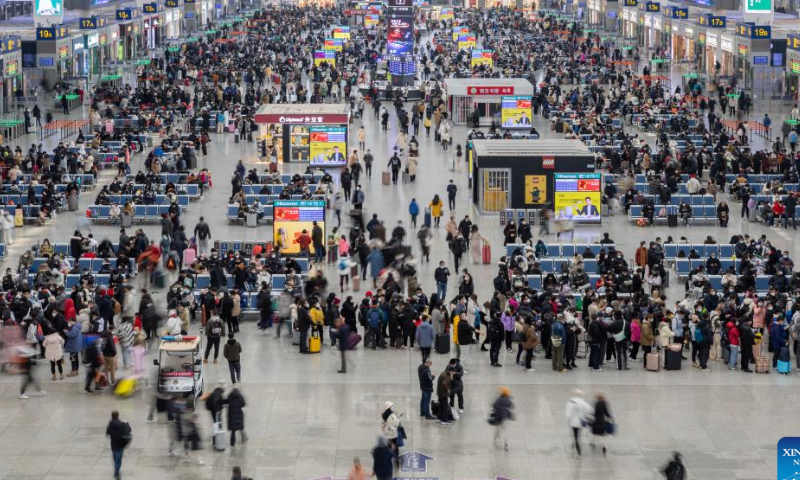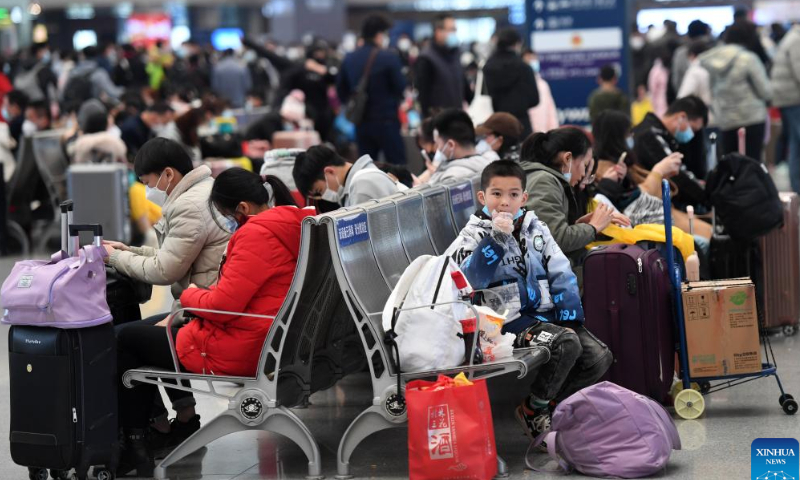
This photo taken on Jan. 27, 2023 shows a view of the waiting hall at Shanghai Hongqiao Railway Station in east China's Shanghai. Railway stations, highways and airports across China are bracing for a fresh travel peak as a growing number of travelers hit the road and return to work after a week-long Spring Festival holiday which ends on Friday. Photo: Xinhua
China is poised to withstand the hard COVID test for the Spring Festival holidays as most cities and regions have already passed their infection peaks, and adequate preparations and contingency plans put in place by authorities at all levels, the hard work of medical workers as well as enhanced vaccinations have allowed residents to enjoy a safe and warm Spring Festival without triggering a large-scale resurgence of infections so far.
Unlike some Western media outlets that predicted China's small cities and rural areas would see tsunami-like infections following the Spring Festival travel rush, not only the country witnessed a warm and joyful Spring Festival with its airports, bus and train stations fully crowded - images that have not been seen in the past three years, it also gradually reopens to the world with a total of 2.45 million trips crossing the border during
the Spring Festival travel peak.
During the Spring Festival holidays, Global Times reporters visited different localities
from North China's Shanxi to Southwest China's Chongqing to Central China's Hubei. In these regions the number of positive cases has been largely declining during the holidays and only limited number of patients was hospitalized. The pressure on local fever clinics has also eased.
According to data released by the Chinese Center for Disease Control and Prevention (China CDC) on Saturday, as of Thursday, 1.31 billion people in the Chinese mainland have been vaccinated, among them 1.28 billion have been fully vaccinated. Among those above 60 years old, 241.6 million have been vaccinated while 230 million are fully vaccinated.
The CDC's report on Wednesday also said the number of COVID infections and visits to fever clinics across the country reached their peak with
the new infections surpassing 7 million and visits to fever clinics reaching 2.87 million on a daily basis. Wu Zunyou, chief epidemiologist of China's CDC, also said that the likelihood of a large nationwide rebound or a second wave in the next two to three months is small, as this wave of the epidemic has already infected about 80 percent of the population.
The country has passed the infection peaks so quickly, which helped enhance the herd immunity in an unprecedented way, Zeng Guang, former chief epidemiologist of China's CDC, told the Global Times on Saturday.
The CDC report also pointed out that based on the reported positive cases through mass testing, the number of infections reached the peak on December 22 with 6.94 million, and dropped to the lowest point of 15,000 on January 23.
Fang Bangjiang, director of the institute of critical care and severe illness of Shanghai University of Traditional Chinese Medicine, was quoted as saying in media reports on Saturday that the transmission of COVID has been gradually weakened not because the virus itself has undergone important changes but because there has been low level of transmission in society thanks to the herd immunity.
The curves of infections from the peak to low ebb then to the peak show a cyclical development, which is also in line with the development of the virus, Qiao Shubin, director of respiratory and critical care department of Fengtai District Hospital of Integrated Traditional Chinese and Western Medicine in Beijing, was quoted as saying in media reports on Saturday. "In countries like the US and Japan, they also experienced several infection peaks."
In 2023, we'll see the people-to-people exchange largely resume domestically and internationally, and there's low possibility that the imported variants will trigger another large-scale infection like we experienced in the past month, an expert close to China's CDC who preferred not to be named told the Global Times on Saturday.
"Meanwhile, the number of severe cases and deaths will both drop in the next waves," he said, referring to the rule of virus transmission and other countries' experiences.

Passengers wait at Nanning East Railway Station in Nanning, south China's Guangxi Zhuang Autonomous Region, Jan. 27, 2023. Railway stations, highways and airports across China are bracing for a fresh travel peak as a growing number of travelers hit the road and return to work after a week-long Spring Festival holiday which ends on Friday. Photo: Xinhua
Better position? As China is experiencing the test of the world's largest human migration amid the COVID waves, there have been discussions about whether the world is prepared to lower the COVID response. The WHO's emergency committee on COVID held its 14th meeting since the start of the pandemic on Friday -- the panel meets every three months, according to media reports.
During an interview with China Newsweek - a Beijing-based magazine, Gao Fu, former director of China CDC said there are two key words when talking about ending the pandemic: tolerance and resilience.
When we can tolerate the virus with some resilience, live a normal life and survive together, the pandemic is over, Gao was quoted as saying in the media report. "When COVID-19 only prevails in some areas, it becomes endemic."
"It's likely that the WHO will announce that the pandemic is over in the summer or autumn, but it does not mean the fatality caused by COVID will be lower than that of flu given the infection of large population," Gao predicted.
Chen Xi, associate professor of health policy & economics at Yale University, told the Global Times on Saturday that the WHO is likely to make the accurate judgment in the next meeting and it's not the time to announce the end of the pandemic now.
"It is still the winter in the northern hemisphere and many countries are still seeing rapid increases in infections, or have just passed the infection peaks. The overall infection and fatality rates are still higher than other infectious diseases," he said.
Also, once the announcement is made, countries may further reduce the investment in the public health, which will pose a threat to local authorities in monitoring the new variants and in sharing information timely, Chen said.
There are some requirements to be met in terms of lowering the COVID response globally, including further lowering the fatality rate and increasing accessibility of vaccines and antiviral drugs, experts said.
WHO chief Tedros Adhanom Ghebreyesus told a briefing on Friday that the global response remains hobbled because in too many countries, these powerful, life-saving tools are still not getting to the populations that need them the most - especially older people and health workers.
"While we are clearly in better shape than three years ago when this pandemic first hit, the global collective response is once again under strain," Tedros was quoted as saying in media reports last week.





